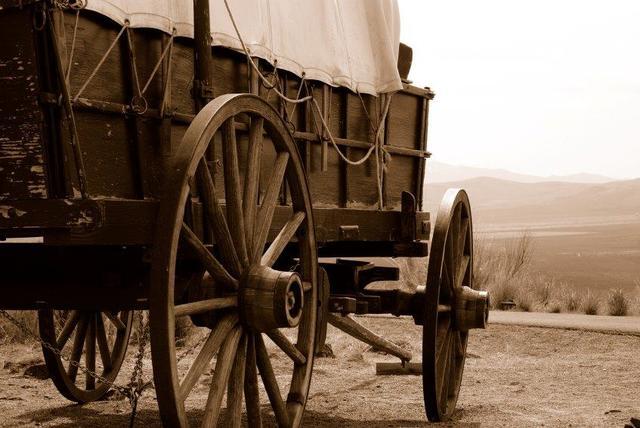Nothing can compare to the feeling that comes when President Thomas S. Monson starts in on one of his famous stories. The emotion and power behind his words can make us not only laugh and cry, but have a desire to truly change our lives. So, in honor of Pioneer Day, we wanted to share three of our favorite pioneer stories shared by President Monson throughout the years--pioneer stories that show how they can come from all ages and parts of the world.
The Silent Violin
Each of us has a heritage—whether from pioneer forebears, later converts, or others who helped to shape our lives. This heritage provides a foundation built of sacrifice and faith. Ours is the privilege and responsibility to build on such firm and stable footings.
A story written by Karen Nolen, which appeared in theNew Era in 1974, tells a pioneer story of a Benjamin Landart who, in 1888, was 15 years old and an accomplished violinist. Living on a farm in northern Utah with his mother and seven brothers and sisters was sometimes a challenge to Benjamin, as he had less time than he would have liked to play his violin. Occasionally his mother would lock up the violin until he had his farm chores done, so great was the temptation for Benjamin to play it.
In late 1892 Benjamin was asked to travel to Salt Lake to audition for a place with the territorial orchestra. For him, this was a dream come true. After several weeks of practicing and prayers, he went to Salt Lake in March of 1893 for the much anticipated audition. When he heard Benjamin play, the conductor, a Mr. Dean, told Benjamin he was the most accomplished violinist he had heard west of Denver. He was told to report to Denver for rehearsals in the fall and learned that he would be earning enough to keep himself, with some left over to send home.
A week after Benjamin received the good news, however, his bishop called him into his office and asked if he couldn’t put off playing with the orchestra for a couple of years. He told Benjamin that before he started earning money there was something he owed the Lord. He then asked Benjamin to accept a mission call.

Benjamin felt that giving up his chance to play in the territorial orchestra would be almost more than he could bear, but he also knew what his decision should be. He promised the bishop that if there were any way to raise the money for him to serve, he would accept the call.
When Benjamin told his mother about the call, she was overjoyed. She told him that his father had always wanted to serve a mission but had been killed before that opportunity had come to him. However, when they discussed the financing of the mission, her face clouded over. Benjamin told her he would not allow her to sell any more of their land. She studied his face for a moment and then said, “Ben, there is a way we can raise the money. This family [has] one thing that is of great enough value to send you on your mission. You will have to sell your violin.”
Ten days later, on March 23, 1893, Benjamin wrote in his journal: “I awoke this morning and took my violin from its case. All day long I played the music I love. In the evening when the light grew dim and I could see to play no longer, I placed the instrument in its case. It will be enough. Tomorrow I leave [for my mission].”
Forty-five years later, on June 23, 1938, Benjamin wrote in his journal: “The greatest decision I ever made in my life was to give up something I dearly loved to the God I loved even more. He has never forgotten me for it.”
(From "In Search of Treasure," April 2003)
Finding a Fulness of Joy
In about March 1946, less than a year after the end of the war, Ezra Taft Benson, then a member of the Quorum of the Twelve, accompanied by Frederick W. Babbel, was assigned a special postwar tour of Europe for the express purpose of meeting with the Saints, assessing their needs, and providing assistance to them. Elder Benson and Brother Babbel later recounted, from a testimony they heard, the experience of a Church member who found herself in an area no longer controlled by the government under which she had resided.
She and her husband had lived an idyllic life in East Prussia. Then had come the second great world war within their lifetimes. Her beloved young husband was killed during the final days of the frightful battles in their homeland, leaving her alone to care for their four children.
The occupying forces determined that the Germans in East Prussia must go to Western Germany to seek a new home. The woman was German, and so it was necessary for her to go. The journey was over a thousand miles (1,600 km), and she had no way to accomplish it but on foot. She was allowed to take only such bare necessities as she could load into her small wooden-wheeled wagon. Besides her children and these meager possessions, she took with her a strong faith in God and in the gospel as revealed to the latter-day prophet Joseph Smith.
She and the children began the journey in late summer. Having neither food nor money among her few possessions, she was forced to gather a daily subsistence from the fields and forests along the way. She was constantly faced with dangers from panic-stricken refugees and plundering troops.
As the days turned into weeks and the weeks to months, the temperatures dropped below freezing. Each day, she stumbled over the frozen ground, her smallest child—a baby—in her arms. Her three other children struggled along behind her, with the oldest—seven years old—pulling the tiny wooden wagon containing their belongings. Ragged and torn burlap was wrapped around their feet, providing the only protection for them, since their shoes had long since disintegrated. Their thin, tattered jackets covered their thin, tattered clothing, providing their only protection against the cold.
Soon the snows came, and the days and nights became a nightmare. In the evenings she and the children would try to find some kind of shelter—a barn or a shed—and would huddle together for warmth, with a few thin blankets from the wagon on top of them.
She constantly struggled to force from her mind overwhelming fears that they would perish before reaching their destination.
And then one morning the unthinkable happened. As she awakened, she felt a chill in her heart. The tiny form of her three-year-old daughter was cold and still, and she realized that death had claimed the child. Though overwhelmed with grief, she knew that she must take the other children and travel on. First, however, she used the only implement she had—a tablespoon—to dig a grave in the frozen ground for her tiny, precious child.

Death, however, was to be her companion again and again on the journey. Her seven-year-old son died, either from starvation or from freezing or both. Again her only shovel was the tablespoon, and again she dug hour after hour to lay his mortal remains gently into the earth. Next, her five-year-old son died, and again she used her tablespoon as a shovel.
Her despair was all consuming. She had only her tiny baby daughter left, and the poor thing was failing. Finally, as she was reaching the end of her journey, the baby died in her arms. The spoon was gone now, so hour after hour she dug a grave in the frozen earth with her bare fingers. Her grief became unbearable. How could she possibly be kneeling in the snow at the graveside of her last child? She had lost her husband and all her children. She had given up her earthly goods, her home, and even her homeland.
In this moment of overwhelming sorrow and complete bewilderment, she felt her heart would literally break. In despair she contemplated how she might end her own life, as so many of her fellow countrymen were doing. How easy it would be to jump off a nearby bridge, she thought, or to throw herself in front of an oncoming train.
And then, as these thoughts assailed her, something within her said, “Get down on your knees and pray.” She ignored the prompting until she could resist it no longer. She knelt and prayed more fervently than she had in her entire life:
“Dear Heavenly Father, I do not know how I can go on. I have nothing left—except my faith in Thee. I feel, Father, amidst the desolation of my soul, an overwhelming gratitude for the atoning sacrifice of Thy Son, Jesus Christ. I cannot express adequately my love for Him. I know that because He suffered and died, I shall live again with my family; that because He broke the chains of death, I shall see my children again and will have the joy of raising them. Though I do not at this moment wish to live, I will do so, that we may be reunited as a family and return—together—to Thee.”
When she finally reached her destination of Karlsruhe, Germany, she was emaciated. Brother Babbel said that her face was a purple-gray, her eyes red and swollen, her joints protruding. She was literally in the advanced stages of starvation. In a Church meeting shortly thereafter, she bore a glorious testimony, stating that of all the ailing people in her saddened land, she was one of the happiest because she knew that God lived, that Jesus is the Christ, and that He died and was resurrected so that we might live again. She testified that she knew if she continued faithful and true to the end, she would be reunited with those she had lost and would be saved in the celestial kingdom of God.
From the holy scriptures we read, “Behold, the righteous, the saints of the Holy One of Israel, they who have believed in [Him], they who have endured the crosses of the world, … they shall inherit the kingdom of God, … and their joy shall be full forever.”
(From "Be of Good Cheer," April 2009)
Appreciating Those Who've Gone Before
I feel to express thanks to my Heavenly Father for His countless blessings to me. I can say, as did Nephi of old, that I was born of goodly parents, whose own parents and grandparents were gathered out of the lands of Sweden and Scotland and England by dedicated missionaries. As those missionaries bore humble testimonies, they touched the hearts and the spirits of my forebears. After joining the Church, these noble men, women, and children made their way to the valley of the Great Salt Lake. Many were the trials and heartaches they encountered along the way.
In the spring of 1848, my great-great-grandparents, Charles Stewart Miller and Mary McGowan Miller, who had joined the Church in their native Scotland, left their home in Rutherglen, Scotland, and journeyed to St. Louis, Missouri, with a group of Saints, arriving there in 1849. One of their 11 children, Margaret, would become my great-grandmother.
While the family was in St. Louis working to earn enough money to complete their journey to the Salt Lake Valley, a plague of cholera swept through the area, leaving death and heartache in its wake. The Miller family was hard hit. In the space of two weeks, four of the family members succumbed. The first, on June 22, 1849, was 18-year-old William. Five days later Mary McGowan Miller, my great-great-grandmother and the mother of the family, died. Two days afterward, 15-year-old Archibald passed away, and five days after his death, my great-great-grandfather, Charles Stewart Miller, father of the family, succumbed. The children who survived were left orphans, including my great-grandmother Margaret, who was 13 years old at the time.
Because of so many deaths in the area, there were no caskets available, at any price, in which to bury the deceased family members. The older surviving boys dismantled the family’s oxen pens in order to make caskets for the family members who had passed away.

Little is recorded of the heartache and struggles of the nine remaining Miller children as they continued to work and save for that journey their parents and brothers would never make. We know that they left St. Louis in the spring of 1850 with four oxen and one wagon, arriving finally in the Salt Lake Valley that same year.
Others of my ancestors faced similar hardships. Through it all, however, their testimonies remained steadfast and firm. From all of them I received a legacy of total dedication to the gospel of Jesus Christ. Because of these faithful souls, I stand before you today.
(From "Looking Back and Moving Forward," April 2008)




